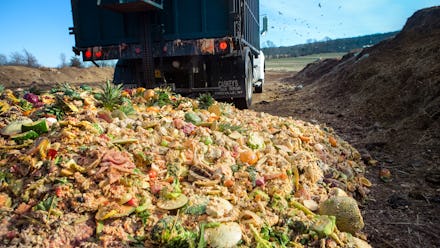There's now a simple way to turn food into fuel, and it could change everything

Food waste is a global problem: One-third of food produced for human consumption (that’s 1.3 billion tons) gets lost or wasted every year. Not only is it an expensive waste of resources, but it is an insulting reality to live with considering 795 million people — one in nine people — suffer from chronic undernourishment.
Now, researchers at Cornell University have found a way to turn food waste into something useful. In the journal Bioresource Technology, the engineers outline a two-step process that converts tossed away ingredients into fuel.
“Food waste should have a high value. We’re treating it as a resource, and we’re making marketable products out of it,” Roy Posmanik, a postdoctoral researcher at Cornell University and lead author of the study, said in a statement. “Food waste is still carbon – a lot of carbon.”
The first step is hydrothermal liquefaction, which effectively extracts all energy from the waste. During this step, the food waste produces crude bio-oil after being pressure cooked at a temperature of 200 to 350 degrees Celsius and at a pressure of 2 to 20 megapascal. The crude oil can then later be refined to create liquid biofuel.
What’s left of the waste — wastewater that contains dissolved organic carbon — proceeds to the second step: anaerobic digestion. This procedure lets microbes anaerobically digest the waste, which is now in an aqueous state, resulting in biomethane within a matter of days; the gaseous compound has potential to generate electricity and heat.
Turning waste into energy using anaerobic digesters is nothing new: It’s a relatively common procedure used around the world to break down organic matter into various types of fuel. What makes this system unique is the use of hydrothermal liquefaction prior to anaerobic digestion. Not only does this speed up the process significantly, it also retrieves more energy.
“If you used just anaerobic digestion, you would wait weeks to turn the food waste into energy,” Posmanik said. “The aqueous product from hydrothermal processing is much better for bugs in anaerobic digestion than using the raw biomass directly. Combining hydrothermal processing and anaerobic digestion is more efficient and faster. We’re talking about minutes in hydrothermal liquefaction and a few days in an anaerobic digester.”
In the lab setting, the researchers used a combination of fats, proteins and sugars in lieu of food. Should this two-step technique become mainstream, then it means we could reuse discarded food and reduce the global carbon footprint.
“We must reduce the amount of stuff we landfill, and we must reduce our carbon footprint,” Posmanik said. “If we don’t have to extract oil out of the ground to run cars or if we’re using anaerobic digestion to make green electricity, we’re enhancing energy and food security.”